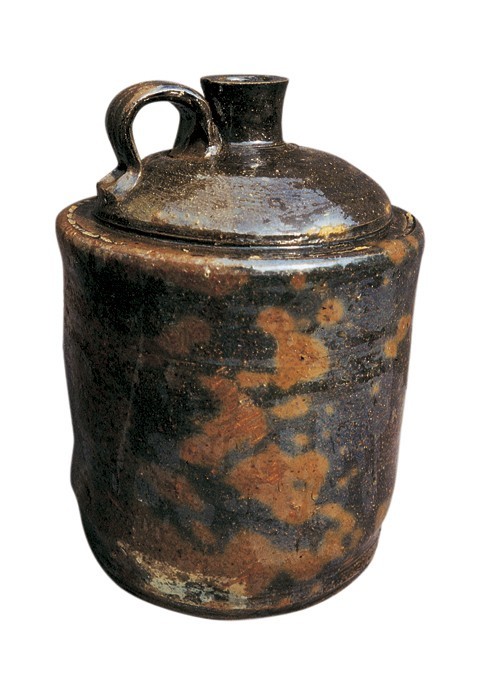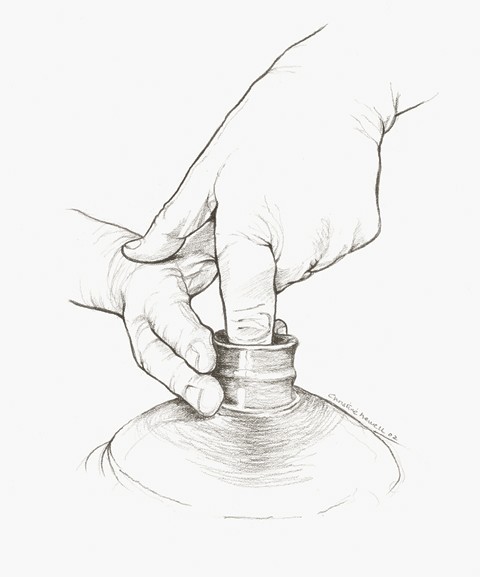
Jug, W. F. Hahn, Edgefield, South Carolina, 1883–1889. Stoneware with alkaline glaze. (Photo, Mark Newell.)

Jug, T. L. Hahn, Edgefield, South Carolina, 1883–1889. Stoneware with alkaline glaze. (Photo, Mark Newell.)

Jug, J. L. Miles, Edgefield, South Carolina, 1862–1872. Stoneware with alkaline glaze. (Photo, Mark Newell.)

Drawing illustrating neck treatment typical of W. F. Hahn. (Drawing, Christine Newell.)

Drawing illustrating neck treatment typical of T. L Hahn. (Drawing, Christine Newell.)
In the 1930s, recognizing that few potters who witnessed the closing years of the Old Edgefield folk pottery tradition remained, the Charleston Museum wittingly compiled information about the vanishing industry. Their efforts resulted in a few typewritten annotations and some very fine acquisitions for the museum’s collections. Included in the accounts is an interview with George Fletcher, a potter from North Augusta, South Carolina, who, with his wheel and clay, came to Charleston to demonstrate the vanishing craft.
During his demonstrations, Fletcher recalled life as a turner in the last productive days of the stoneware potteries of the Old Edgefield District, and conveyed information about his fellow potters, including W. F. (Willie) Hahn, who was noted for his masterfully rendered beaded necks and bowl rims.[1] The museum collected vessels made by Hahn, and stamped “Trenton, SC” and “Augusta, GA.” But other than his unmistakable skill and two places of work, little was known about W. F. Hahn for the next sixty years.
In the late 1980s, interest in Edgefield County’s folk pottery traditions was renewed by avocational researchers, as well as by scholars at the McKissick Museum at the University of South Carolina, who had begun collecting histories and archival material on the subject. The museum’s research resulted in Great and Noble Jar, the first major book on the potteries, by Cinda K. Baldwin. She wrote that a potter named Hahn worked at the John W. Siegler pottery established in 1853 on Shaw’s Creek near Eureka, South Carolina, and that as recently as the 1980s, local residents claimed that Hahn worked there. She also noted that both W. F. Hahn and P. L. Hahn were working in Schultz Township after 1900, and that evidently W. F. Hahn had operated a pottery at Trenton before.[2]
In 1996, the Georgia Archaeological Institute (GAI) of Augusta began a re-assessment of these earlier findings surrounding Edgefield County’s folk pottery traditions. GAI’s program began in North Augusta, South Carolina, which is the present day location of Schultz Township on the Savannah River, opposite Augusta. Although in South Carolina, the area is clearly regarded as an extension of Augusta. Concurrently, much of Willie Hahn’s history was uncovered in the Augusta city directories, archived at the Augusta-Richmond County Library. The accounts provided a glimpse of the fascinating bonds forged by the Edgefield potters through their social contact and working relationships.
As first reported in Ceramics in America (2001), a spectacular discovery of over 600 intact buried vessels was made on the Joseph Gregory Baynham pottery site near Eureka, South Carolina. Analysis of the stoneware vessels showed that, although clearly stamped “JGB,” judging from their necks, William and Thomas Hahn undoubtedly turned a significant volume of the total deposit (figs. 1, 2).
Excavations also revealed that, beneath the Baynham occupation, a preceding pottery produced magnificently turned stonewares dating from at least 1862 to approximately 1872 (fig. 3). Exhibiting a clay body, style, and beautiful green alkaline glazes, these earlier vessels are vastly superior and different from those of the Baynham era. They are believed to be from the pottery run by John Lewis Miles, the son of Lewis Miles, one of the most significant of the earlier Edgefield area potters.[3]
Both Hahns apparently worked for Joseph Baynham for six years before moving to Schultz Township in 1889. When he was fifty-one, W. F. Hahn established his Schultz Township pottery on the corners of West and Bluff Avenues in 1899. His twenty-eight-year-old son, Thomas L. Hahn, worked as a potter for the Southern Pottery Company in Schultz Township, also in the same year.[4] Two years after his father died in 1908, Thomas established his own pottery a few blocks from his father’s old business on Railway Avenue in what had by then become North Augusta, South Carolina.
Since father and son were working at different potteries at the same time, GAI researchers surveyed local collections and compared the well-known “Hahn” beaded necks on vessels from the W. F. Hahn Pottery, Augusta works, and the Southern Pottery Company. A clear difference in potting techniques between father and son emerged. Necks produced by W. F. Hahn possess a distinct center ridge around the middle of the neck (fig. 4); necks turned by T. L. Hahn at Southern Pottery do not (fig. 5).
In an attempt to understand the differences, many Hahn-style vessels were reproduced in the GAI pottery laboratory. It was discovered that turning the neck with two extended fingers resulted in the “finger-ridge” on W. F. Hahn’s vessels; the ridge was caused by the slight v-shape between the fingers. By using the side of the palm to lift up the neck, smooth elegant necks like the T. L. Hahn necks were duplicated. Later excavations of the 1908 T. L. Hahn pottery confirmed Thomas’ distinctive style. Produced two years after W. F. Hahn’s death, all of the necks recovered were smooth and showed no signs of the middle finger ridge. This discovery, coupled with the hands-on experimentation, led to new insights that allowed archaeologists to identify who turned what at the Baynham pottery site. Also, based on archaeological evidence found there, W. F. Hahn apparently burned pottery at the old Miles kiln prior to Baynham’s purchase of the property in the early 1870s.
Willie died in North Augusta in 1906 and was buried in Graniteville Cemetery next to his wife’s family plot in Graniteville, South Carolina.[5] A few years later, his wife, Sarah, was buried next to him. Almost fifty years later, Tommy, who had become a prominent Augusta attorney by the time of his death, was laid next to him, as was Tommy’s wife.
The role played by “Hahn” in the latter years of the Old Edgefield pottery tradition has two distinct faces: those of Willie and Tommy, as they are now affectionately known. Although a great deal more about the contribution of the Hahns to the Edgefield pottery tradition is known, one mystery remains: the Hahns’ origin. That the elder Hahn may have come from Germany is just an assumption. Some collectors believe that Willie came from the Kirksey area where his name was Willie Horne, and that when he married Sally Durham from Graniteville, South Carolina, he changed his name to Hahn, a more socially prominent family name in the area. Is there any truth to the story? It is true that Horne and Hahn are considered interchangeable names in the area to this very day.
Mark M. Newell, Ph.D.
Director
Georgia Archaeological Institute
<mmnewell@yahoo.com>
Notes collected by “Miss L.M.B. and E.B.C.,” Charleston Museum Archives, June 1930.
Cinda K. Baldwin, Great and Noble Jar ( Athens, Ga.: University of Georgia Press, 1993).
Maloney City Directory, 1899, p. 403. On file at Augusta-Richmond County Library, Augusta, Ga.
South Carolina 1870 Census, Department of Archives and History, Columbia, S.C.
Graniteville Cemetery Association, Register of Burials, 1906, p. 20.
